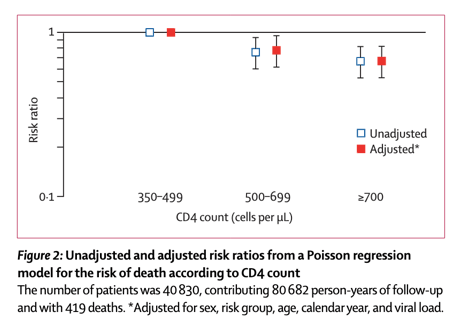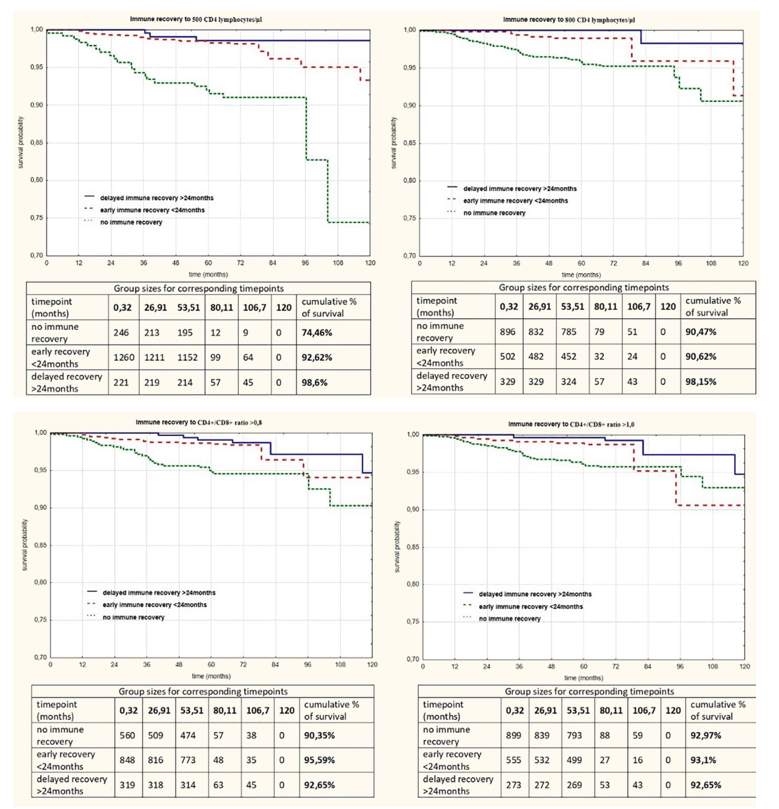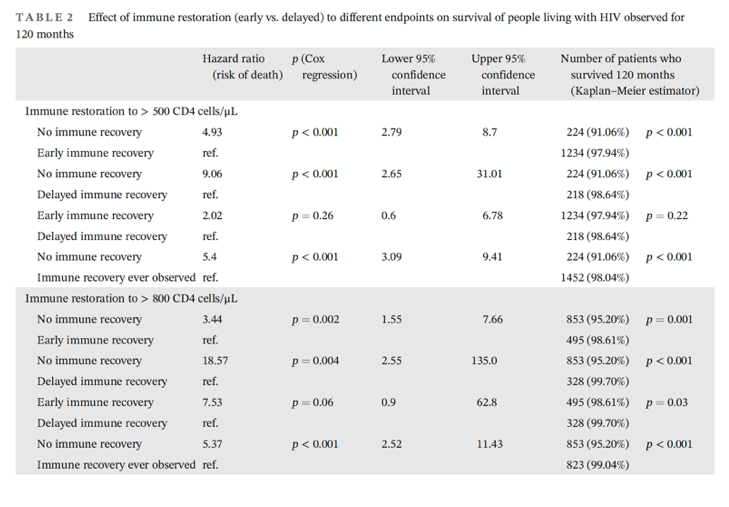| |
Immune restoration affects 10-year survival in
people living with HIV/AIDS: CD4 >500 & nadir CD4 matter
|
| |
| |
Download the PDF here
-------------------------
CD4 Count Under 700 Linked to All-Cause Mortality in Veterans Cohort
Compared with CD4 counts of 350-499 cells per μL, death rate was lower in patients with counts of
500-699 cells per μL (adjusted rate ratio 0•77, 95% CI 0•61-0•95) and counts of 700 cells per μL (0•66, 0•52-0•85).
We calculated standardised mortality ratios (SMRs)

Long-term Mortality in HIV-Positive Individuals Virally Suppressed for >3 Years With Incomplete CD4 Recovery
In multivariate analysis, higher mortality was observed in patients with CD4 response levels 350-499 cells/ml [adjusted hazard ratio (aHR) 1.70, 95% confidence interval (CI) 1.26-2.30] and for those
between 200-349 (aHR 2.56; 95% CI 1.93-3.38), compared to those with 500 cells/ml or more.
--------------------
New study from Poland reports:
Immune restoration remains a powerful factor for improving the survival of PLWH, regardless of the speed of recovery. Due to the ageing of the PLWH population, an increasing number of highly effective ARTs, and the increasing clinical observation of patients, acquiring immune restoration is an achievable goal in the care of PLWH.
• Immune restoration to values of 500 and 800 CD4 cells/μL had the greatest effect on the survival of PLWH. We found a more than five-fold decrease in mortality in patients whose CD4 lymphocyte counts were > 500 cells/μL or 800 cells/μL.
• In addition to immune restoration, the CD4 lymphocyte count nadir was also associated with mortality, as patients with a nadir CD4 lymphocyte count of < 100 or < 200 cells/μL showed a greater than two-fold or three-fold increased risk of mortality, respectively.
Viral load at the time of diagnosis did not affect mortality in this cohort, either as a continuous variable (p = 0.9) or as the categorical variable, lower or higher than 5 log copies/mL (p = 0.53)."
Reaching the > 500 CD4 cells/μL endpoint had a statistically significant effect on survival compared with not achieving immune recovery (HR = 5.4, IQR: 3.09-9.41, p < 0.001). Furthermore, significantly higher mortality risks were observed when comparing early immune recovery with no recovery and delayed recovery with no recovery (HR = 4.93, IQR: 2.79-8.7, p < 0.001 and HR = 9.06, IQR: 2.65-31.01, p < 0.001, respectively).
The same association with survival was seen in those who reached the > 800 CD4 cells/μL endpoint (HR = 5.37, IQR: 2.52-11.43, p < 0.001) in comparison to those who did not achieve immunorestoration. Furthermore, early immune restoration appears to be beneficial (HR = 3.44, IQR: 1.55-7.66, p = 0.002), and for those patients whose CD4 lymphocytes were restored later, this effect on survival was also shown (HR = 18.57, IQR: 2.55-135.0, p = 0.004).
Meeting the CD4/CD8 lymphocyte ratio threshold showed less of a protective effect, with a two-fold (for a ratio > 1.0) to three-fold (for a ratio > 0.8) reduction in mortality risk.
in some cases reaching an 18-fold decrease in the risk of mortality (immune restoration up to 800 CD4 cells/μL over 24 months of observation). However, during the course of the analysis, no significant differences were found between patients who achieved immune restoration in < or > 24 months.
This was in contrast to the findings of other studies, in which baseline viraemia was found to be a prognostic factor for both the course of infection and mortality [35-37]. It is worth noting that, in this study, the effect of baseline viraemia on mortality was only investigated at the end of the 10-year period. The effect of HIV viral load on the course of infection and on mortality during the subsequent observation period was not studied, which most probably contributed to the differences in the results for different cohorts.
CONCLUSIONS
Immune restoration remains a powerful factor for improving the survival of PLWH, regardless of the speed of recovery. Due to the ageing of the PLWH population, an increasing number of highly effective ARTs, and the increasing clinical observation of patients, acquiring immune restoration is an achievable goal in the care of PLWH. A properly functioning immune system has an undeniable effect on the progression of disease and the survival of patients. However, there remains a lack of large multi-centre studies that would allow for a better understanding of the immune restoration process and its influencing factors. In the future, an in-depth analysis of the effects of various clinical and genetic factors on immune restoration is necessary.
Abstract
Introduction
In recent years, a reduction in the life expectancy gap between people living with HIV (PLWH) and the general population has been observed, irrespective of CD4 lymphocyte count, due to widespread access to antiretroviral treatment. The increase in the life expectancy of PLWH has increased awareness of both the ageing process and gender discrepancies in immune restoration and survival.
Materials and Methods
Longitudinal data were collected for 2240 patients followed up at the Hospital for Infectious Diseases in Warsaw, Poland (n = 1482), and the Department of Acquired Immunodeficiency, Pomeranian Medical University, Szczecin, Poland (n = 758). Immune restoration was measured from the time of starting combination antiretroviral therapy until achieving 500 CD4 lymphocytes/μL, 800 CD4 lymphocytes/μL, and CD4/CD8 lymphocyte ratios of > 0.8 and > 1.0. Full recovery was achieved when the patient was restored to both 800 CD4 lymphocytes/μL and a CD4/CD8 lymphocyte ratio > 1.0.
Results
For all endpoints, immune restoration had a protective effect by reducing mortality. Patients who achieved immune restoration had a greater chance of reduced mortality than those who did not achieve immune restoration: for CD4 count > 500 cells/μL, HR = 5.4(interquartile range: 3.09-9.41), p < 0.001; for CD4 > 800 cells/μL, HR = 5.37 (2.52-11.43), p < 0.001; for CD4/CD8 ratio > 0.8, HR = 3.16 (1.81-5.51), p < 0.001; for CD4/CD8 ratio > 1.0, HR = 2.67 (1.49-5.24), p = 0.001, and for full immune recovery, HR = 3.62 (1.63-8.04), p = 0.002.
Immune restoration was measured from the time point of starting combined ART until achieving 500 CD4 lymphocytes/μL, 800 CD4 lymphocytes/μL and CD4/CD8 lymphocyte ratios > 0.8 and > 1.0. Full recovery was indicated when the patient restoration resulted in both 800 CD4 lymphocytes/μL and a CD4/CD8 lymphocyte ratio > 1.0. Survival analysis was performed until the patient's death or 1 August 2020, whichever occurred sooner. For each patient, immune restoration was estimated over a period of 120 months.
Conclusions
Immune restoration remains a powerful factor in improving the survival of PLWH, regardless of the speed of recovery.
The factor that affected mortality was a nadir of CD4 lymphocyte counts in the categories of < 100 and < 200 cells/μL. A lower nadir CD4 lymphocyte count corresponded to a higher mortality rate [hazard ratio (HR) = 2.52, IQR: 1.28-4.95, p = 0.007 for a nadir of < 100 cells/μL; and HR = 3.81, IQR: 2.16-6.72, p < 0.001 for a nadir of < 200 cells/μL].
Viral load at the time of diagnosis did not affect mortality in this cohort, either as a continuous variable (p = 0.9) or as the categorical variable, lower or higher than 5 log copies/mL (p = 0.53).
Survival analysis of immune restoration
For survival analysis, immune restoration was classified as early immune recovery (< 24 months after diagnosis), delayed immune recovery (> 24 months after diagnosis) or no recovery (Figure 1). In addition to these groups, the patients were divided into two groups based on immune recovery and no immune recovery during the observation period (Figure 2).
Immune restoration was defined as an increase in the number of CD4 lymphocytes to > 500/μL or > 800/μL or a CD4/CD8 lymphocyte ratio > 0.8 or > 1.0. Additionally, the composite endpoint of full immune restoration was defined as a CD4/CD8 lymphocyte ratio > 1.0 and > 800 CD4 lymphocytes/μL (Table 2).
Reaching the > 500 CD4 cells/μL endpoint had a statistically significant effect on survival compared with not achieving immune recovery (HR = 5.4, IQR: 3.09-9.41, p < 0.001). Furthermore, significantly higher mortality risks were observed when comparing early immune recovery with no recovery and delayed recovery with no recovery (HR = 4.93, IQR: 2.79-8.7, p < 0.001 and HR = 9.06, IQR: 2.65-31.01, p < 0.001, respectively).
The same association with survival was seen in those who reached the > 800 CD4 cells/μL endpoint (HR = 5.37, IQR: 2.52-11.43, p < 0.001) in comparison to those who did not achieve immunorestoration. Furthermore, early immune restoration appears to be beneficial (HR = 3.44, IQR: 1.55-7.66, p = 0.002), and for those patients whose CD4 lymphocytes were restored later, this effect on survival was also shown (HR = 18.57, IQR: 2.55-135.0, p = 0.004).
Similarly, the mortality risk was significantly lower for those who achieved immune restoration to a CD4/CD8 lymphocyte ratio >0.8 (HR = 3.16, IQR: 1.81-5.51, p < 0.001) in comparison to patients without immunoreconstruction, as found in previous analyses both in early restoration (HR = 3.05, IQR: 1.64-5.68, p < 0.001) and delayed restoration (HR = 3.43, IQR: 1.42-8.27, p = 0.006), with higher death risk for patients who were not immunoreconstructed.
Patients who achieved immune restoration to the CD4/CD8 ratio >1.0 endpoint showed better survival than those without immune recovery (HR = 2.67, IQR: 1.49-5.24, p = 0.001). As previously, the same dependency was observed in the early recovery group (HR = 2.52, IQR: 1.22-5.23, p = 0.01) and the delayed recovery group (HR = 3.39, IQR: 1.21-9.53, p = 0.02).
Full immune recovery remained a statistically significant survival-associated factor when compared with no immune recovery (HR = 3.62, IQR: 1.63-8.04, p = 0.002), in both early (HR = 2.89, IQR: 1.04-8.05, p = 0.04) and delayed full immune recovery (HR = 4.43, IQR: 1-34, p = 0.01) with higher mortality risk in the group no immune recovery.
No statistically significant differences were observed between patients with early and delayed immune recovery during the analysis period.


|
|
| |
| |
|
|
|